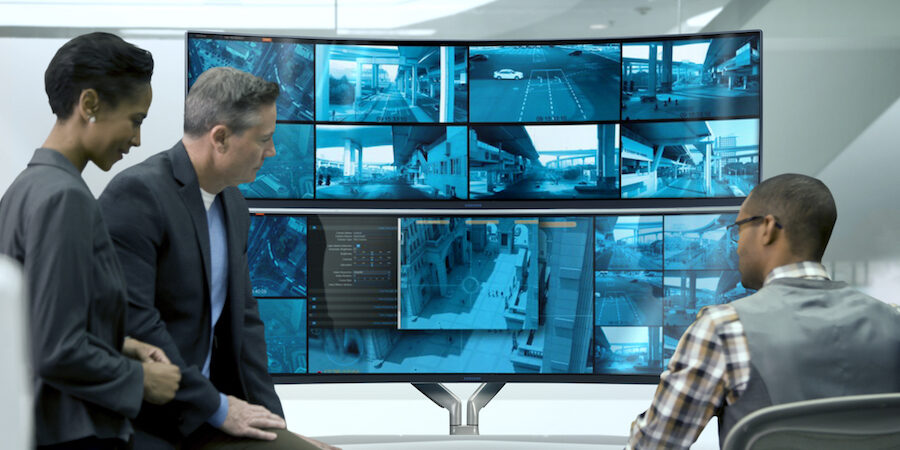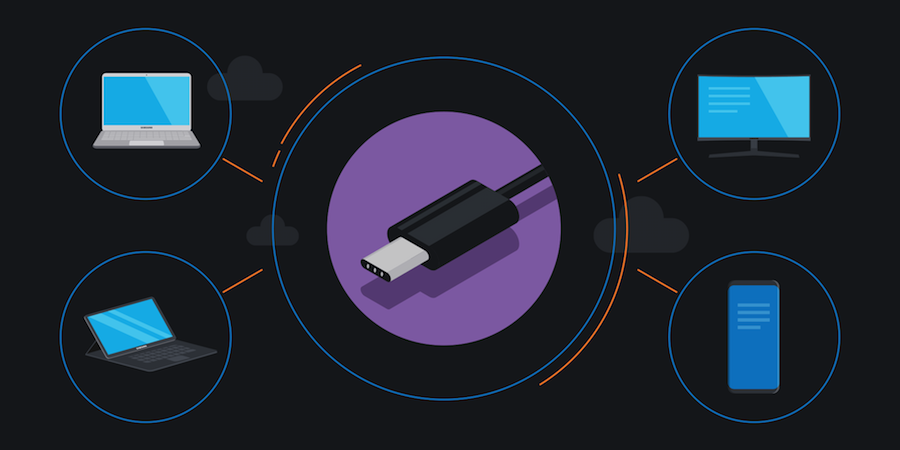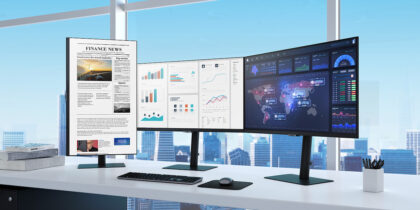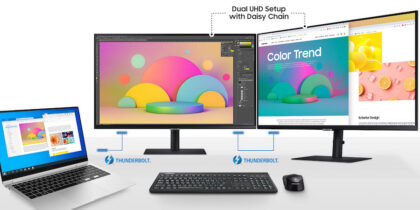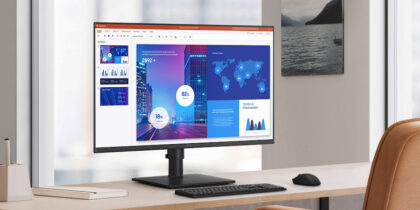As desktop monitors get more sophisticated, the latest models remove cost and clutter from workspace planning. One of the latest advancements integrates a multitasking keyboard, video and mouse (KVM) switch right inside the monitor for maximum efficiency.
A KVM switch is a small hardware device that allows PC users to view and control different computers using just a single keyboard, monitor and mouse. These switches can be used to consolidate equipment and eliminate redundant peripherals by connecting everything through a single configured display. This, in turn, simplifies wire and cable management, saves a significant amount of desk space and centralizes operations.
One line of desktop monitors — like Samsung’s 43-inch CJ890 Super Ultra-Wide Curved Monitor — has a KVM switch built in. On a single display, users can switch between different computer inputs and controls, and even set keyboard hotkeys to quickly access different PCs.
How does a KVM switch work?
KVM switches are particularly valuable for workstations and gaming setups where multiple PCs or other computing devices feed into one desktop screen. While some multitaskers can work by running numerous apps on a single monitor with a built-in PC, some circumstances require different devices for different tasks.
The complete guide to USB Type-C
Learn how to clear desk space, streamline workflow and save time and money with USB-C connectors. Download Now
Without a KVM switch, you have to reach behind your monitor, plug in different devices and fiddle with a series of controls and settings to get the desired input on screen — hopefully at the proper resolution. It’s needlessly complex, and can end up causing more headaches for IT.
Cutting cost and clutter
KVM switches come in a wide variety of costs and capabilities. It’s possible to source entry-level devices for less than $50, but switches at that price point will deliver consumer-grade technology, which will probably prove unreliable for your organization’s operating needs.
When businesses adopt monitors with a built-in KVM switch, that cost is gone. In a large enterprise rollout, the savings prove significant. Trimming even $150 per KVM unit out of a capital budget for 100 workstations would represent a total savings of $15,000.
Just as importantly, a KVM switch opens up more working area — think a KVM monitor for a home office. As many companies shrink their available office space and more employees are working from home or in a co-working environment, a monitor with a built-in KVM switch is ideal. Its relatively small size and easy setup save space where it comes at a premium.
Integrated KVM switches also lighten the load on IT support. Generally, the fewer distinct devices that IT has to manage, the fewer potential points of failure. That’s particularly true when the inputs for computing devices are plugged in at installation and then left alone, because the KVM switch handles changing inputs.
Working more efficiently
PC power users are all about working efficiently, using keyboard shortcuts to quickly toggle between various apps. The KVM switch allows multitaskers to jump not only between apps, but also between computers.
This is especially useful in industries where super powerful PCs are necessary to complete tasks like medical and seismic imaging, 3D graphics or video editing. In healthcare, for instance, practitioners often need to review several documents at once, including patients’ electronic health records (EHRs) and preferred pharmacy information, as well as their notes and imaging. With a KVM monitor switch, physicians can easily swap or move windows to get a holistic view of their patient’s health.
Going wide
To better support multitasking, monitors with a built-in KVM switch are often extra-wide, like Samsung’s 43-inch curved monitor.
Users can save even more on costs and space by integrating full USB-C support into their ultrawide monitor with KVM. A USB-C monitor with a KVM switch removes the need for a separate docking station, since the display can function as the hub for a keyboard, mouse and any other peripherals.
An extra-wide monitor also provides a seamless viewing canvas, rather than breaking it into two or more zones bisected by the frames of multiple monitors. This is especially useful for highly visual industries. Security personnel, for example, enjoy a more comprehensive view of all camera inputs, without having to avert their eyes to take care of other pressing tasks.
Large, curved monitors don’t just look nice, they’re also easier on the eyes. On a curved canvas, your eyes are the same distance from every part of the screen, so you don’t need to focus and refocus them as you scan the screen, thus reducing eye strain.
By adding monitors with built-in KVM switches to your fleet, you could see a drastic improvement in your team’s productivity — saving both budget and valuable workspace.
Broaden the boundaries of your performance with Samsung’s high resolution monitors. To help your employees become multitasking power users, outfit their desktop workspaces with USB-C support.
